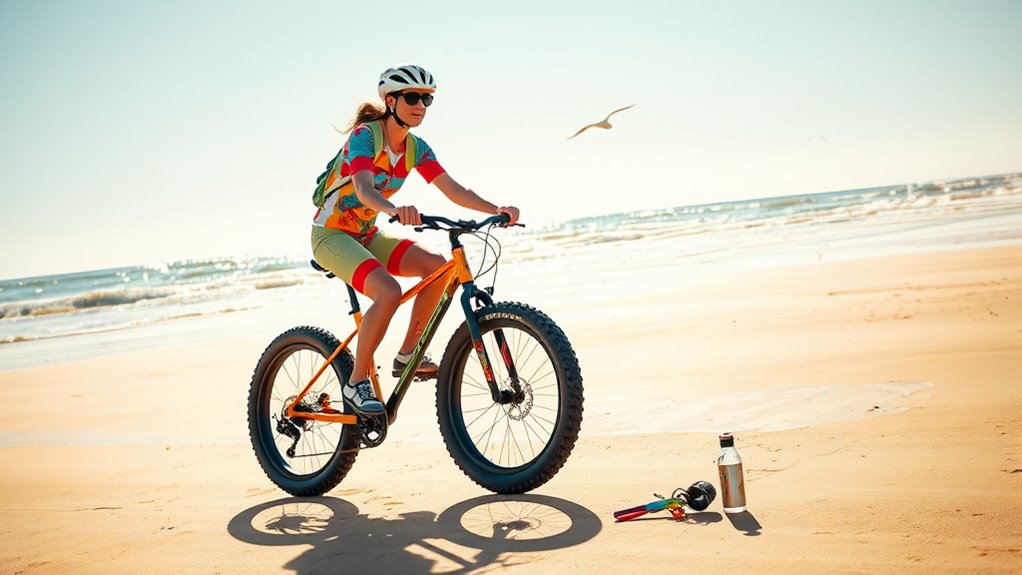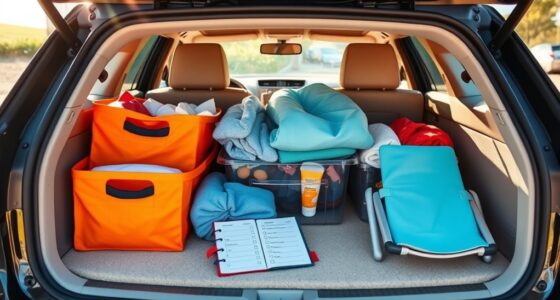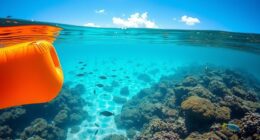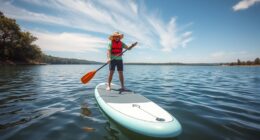To enjoy beach cycling and care for your fat-tire bike, choose a model with wide, low-pressure tires and corrosion-resistant frame. Before riding, clean and inspect your bike, adjusting tire pressure lower for soft sand and maintaining smooth, steady pedaling. Afterward, rinse off salt and sand, dry all parts thoroughly, and lubricate moving components. Using the right accessories and proper maintenance helps prevent rust and prolongs your bike’s lifespan—if you keep going, you’ll discover more helpful tips.
Key Takeaways
- Choose bikes with wide, low-pressure fat tires and corrosion-resistant frames for optimal traction and durability on soft sand.
- Regularly check and maintain tire pressure, keeping it lower for soft terrain to enhance grip and prevent punctures.
- Rinse your bike with fresh water after beach rides to remove salt, sand, and debris, then dry thoroughly to prevent rust.
- Use smooth, steady pedaling, keep weight centered, and avoid sudden turns or braking when riding on soft sand.
- Incorporate accessories like waterproof bags, lights, and tire gauges to improve safety, convenience, and bike care during beach cycling.
Choosing the Right Fat-Tire Bike for Beach Adventures

When selecting a fat-tire bike for beach adventures, it’s vital to take into account the terrain you’ll encounter. If you’ll ride on soft, loose sand, choose a bike with wide, low-pressure tires for better flotation and stability. Look for a sturdy frame that can handle uneven surfaces and resist corrosion from saltwater. You should also consider the bike’s gearing; a wide-range gear system makes pedaling over dunes and soft patches easier. Comfort features like a padded saddle and adjustable handlebars will enhance your ride. Additionally, lightweight models help reduce fatigue on long stretches, while durable components ensure the bike withstands the harsh beach environment. Incorporating advanced materials into your bike’s design can further improve performance and longevity. Selecting a bike with corrosion-resistant components is also essential to ensure durability in salty, humid conditions. Picking the right fat-tire bike will make your beach excursions safer and more enjoyable.
Preparing Your Bike Before Heading to the Beach
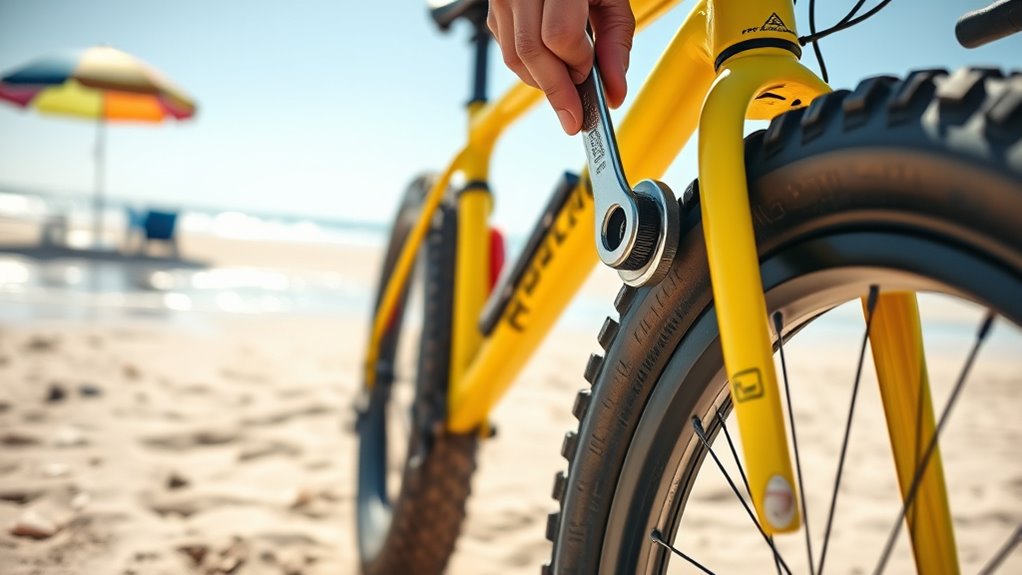
Before you hit the beach, make sure to clean and inspect your bike’s components for any damage. Lubricate the moving parts to keep everything running smoothly, and check your tire pressure to guarantee a safe ride. Taking these quick steps helps you avoid surprises and enjoy your ride without worries.
Clean and Inspect Components
Ensuring your bike is clean and in good shape is essential before heading to the beach, especially with sand and salt present. Start by wiping down the frame, removing any dirt or debris that could scratch the paint or cause corrosion. Check the tires for embedded sand or small stones; remove them to prevent punctures. Inspect the brake pads for wear and ensure they engage smoothly. Look over the chain and gears, making sure they move freely without resistance or rust. Tighten loose bolts and quick-release levers, and verify that wheels are properly aligned. A thorough visual inspection helps catch potential issues early, preventing breakdowns during your ride. Keeping your bike clean and well-inspected guarantees a smoother, safer ride on sandy and salty terrain. Cultivating a mindful approach to bike maintenance can also reduce the likelihood of small errors turning into larger problems. Regularly applying corrosion protection measures is especially important when riding in salty environments to extend your bike’s lifespan. Incorporating routine maintenance practices can further enhance your bike’s durability and performance. Additionally, paying attention to component wear can help identify parts that may need replacement before they fail unexpectedly. Incorporating proper lubrication techniques can also improve the longevity of moving parts and ensure smooth operation.
Lubricate Moving Parts
Have you lubricated your bike’s moving parts recently? Proper lubrication ensures smooth operation and prevents rust, especially near the beach where saltwater can accelerate corrosion. Focus on the chain, derailleurs, brake pivots, and bottom bracket. Use a high-quality bike lubricant designed for wet conditions, applying a small amount to each part. Wipe away excess to prevent dirt and sand from sticking, which can cause wear. Rotate pedals and shift gears to distribute the lubricant evenly. Regular lubrication not only improves performance but also extends your bike’s lifespan. Before heading to the beach, make this quick step part of your routine to keep your bike running smoothly in salty, sandy conditions. It’s a simple way to avoid issues during your ride. Additionally, understanding bike maintenance can help you troubleshoot common problems and keep your cycling experience enjoyable.
Check Tire Pressure
Checking your tire pressure is a quick but essential step to guarantee a smooth ride on the beach. Properly inflated tires improve traction, prevent flats, and make pedaling easier over sand and uneven surfaces. Before heading out, use a reliable pressure gauge to check each tire. For fat tires, the recommended pressure usually falls between 15 and 30 PSI, but check your bike’s specifications. Underinflated tires can cause sluggishness and increase the risk of punctures, while overinflated tires may reduce grip and cause bounce. Adjust the pressure accordingly, especially if you’ll be riding on soft sand or firm paths. Taking a few minutes to ensure your tires are correctly inflated helps you enjoy a safer, more efficient beach cycling experience. Additionally, proper tire maintenance can extend the lifespan of your tires and improve overall bike performance. Regularly inspecting your tires for wear and damage can help prevent unexpected flats and ensure optimal safety during your ride. Incorporating correct inflation techniques can further optimize your bike’s handling and comfort. Proper tire pressure is also crucial for tire durability, as maintaining the right pressure reduces uneven wear and prolongs tire life. Maintaining optimal tire pressure also aligns with projector image quality principles, as proper setup enhances overall performance and safety.
Best Practices for Riding on Sand and Soft Terrain
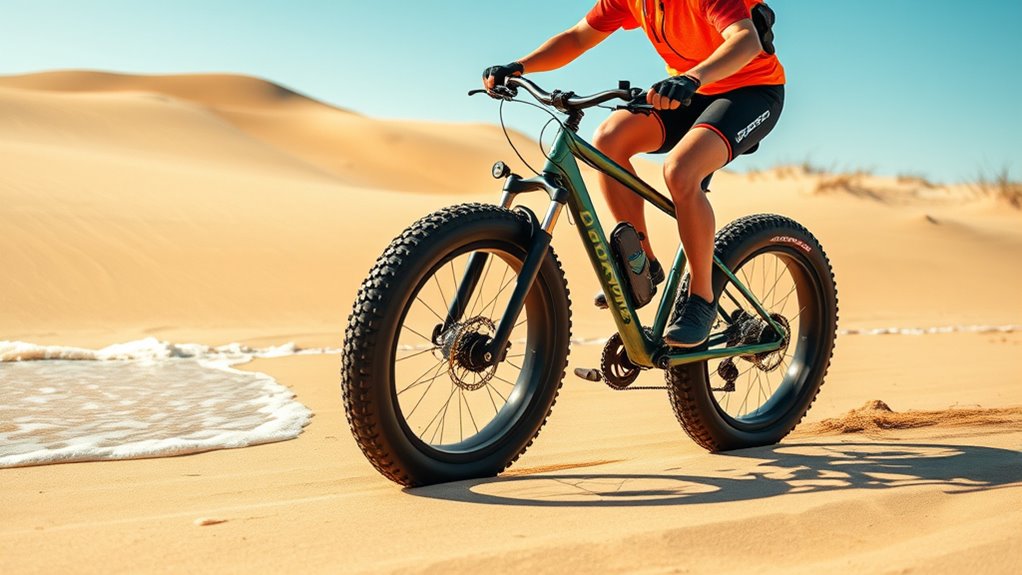
Riding on sand and soft terrain requires a mindful approach to prevent getting stuck or losing control. Keep your tire pressure lower than on hard surfaces to increase traction and surface contact. Maintain a steady, moderate speed to avoid digging into the sand, which can cause you to sink. Use a smooth, consistent pedaling motion, avoiding sudden stops or sharp turns that can destabilize you. Stay seated when possible to keep your bike balanced and prevent wheel spin. Shift to lower gears early to make pedaling easier and prevent strain. Look ahead and choose your path carefully, avoiding soft patches or deep dunes. Being aware of website performance metrics can help you understand how different terrains impact your riding experience. Monitoring cycling terrain conditions can help you adapt your riding style for better control. Incorporating proper fat-tire bike maintenance practices can extend the lifespan of your tires and improve overall handling. Additionally, paying attention to aesthetic wall organization can help you keep your bike gear and accessories neatly stored for quick access during rides. By staying relaxed and attentive, you’ll enjoy a smoother, safer ride on challenging terrain.
Tips for Safe and Comfortable Beach Cycling
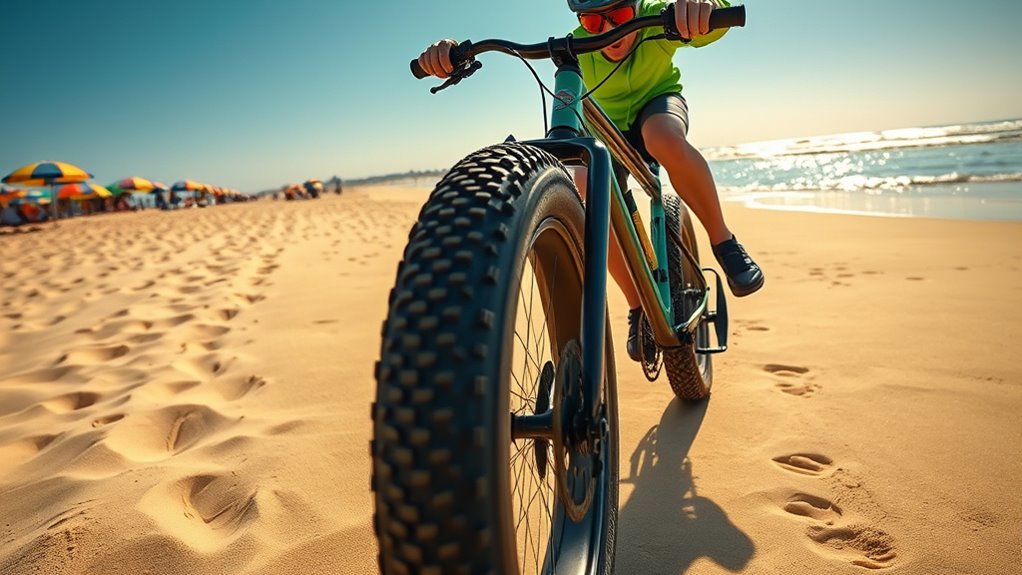
To stay safe and comfortable on the beach, make sure you’re wearing proper gear and suitable attire for the terrain. When steering soft sand, keep your weight back and pedal steadily to avoid getting stuck. These tips will help you enjoy your ride while staying safe and relaxed. For added enjoyment, consider exploring nearby water parks for a refreshing break after your cycling adventure. Additionally, using a fat-tire bike with specialized tires can improve stability and traction on loose sand, making your beach ride more enjoyable. Employing appropriate bike selection methods can further optimize your riding experience. For optimal performance and safety, selecting a bike with upgraded suspension can further enhance your comfort on uneven surfaces. Incorporating the Law of Attraction principles can also help you manifest positive experiences during your outdoor activities.
Proper Gear and Attire
When cycling along the beach, wearing the right gear is essential for safety and comfort. Opt for a well-fitting helmet to protect your head from falls or sudden bumps. Lightweight, moisture-wicking clothing keeps you cool and dry, especially in the sun. Wear sturdy, closed-toe shoes with good grip to handle different terrains and prevent slipping. Sunglasses shield your eyes from glare and sand particles, while sunscreen protects your skin from UV rays. Consider gloves for better grip and to reduce hand fatigue. A lightweight, breathable jacket or vest can be useful if the weather changes. Remember to carry a small backpack or hydration pack with water, snacks, and essentials. Proper gear guarantees you enjoy your beach ride safely and comfortably. Additionally, using self-watering plant pots can help keep your home plants healthy without frequent watering, especially when you’re busy with outdoor activities. Being aware of environmental considerations like avoiding littering and respecting wildlife can help preserve the beauty of the beach for future rides. Incorporating bike maintenance into your routine ensures your bike stays in optimal condition for all terrains. Practicing space and organization by planning your gear setup can also streamline your ride and ensure nothing important is forgotten.
Navigating Soft Sand
Traversing soft sand can be challenging, but with the right technique, you can stay safe and comfortable. To improve your experience, focus on these key tips:
- Maintain a steady, moderate pace to prevent your tires from sinking.
- Keep your weight centered over the bike to maximize traction.
- Use lower tire pressure to increase surface area and grip.
- Avoid sudden turns or braking, which can cause your tires to dig in.
Cleaning and Maintaining Your Fat-Tire Bike After Riding
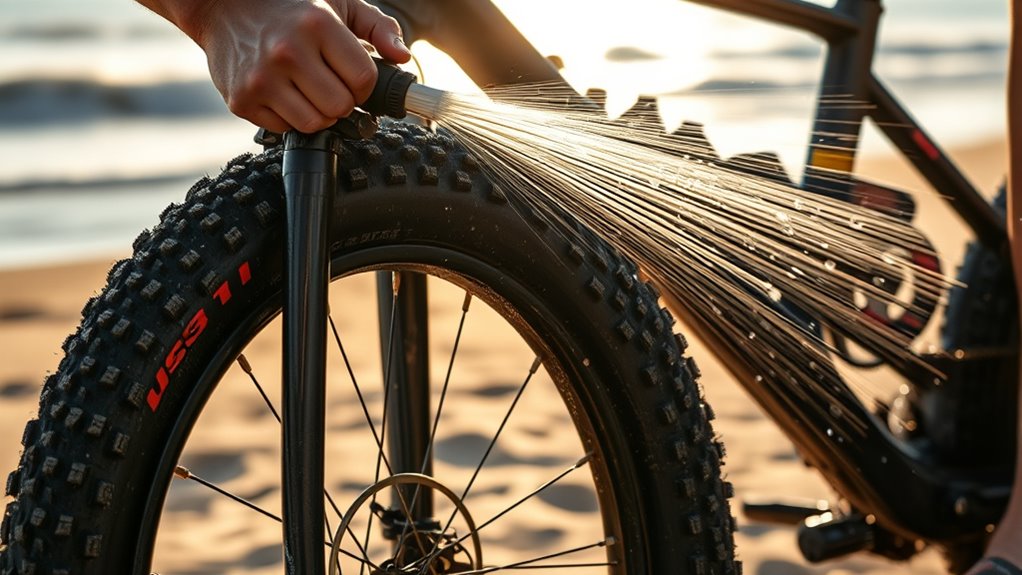
After each ride, it’s essential to clean and maintain your fat-tire bike to keep it in top condition. Start by rinsing off salt, sand, and debris with fresh water, paying special attention to the tires and drivetrain. Use a soft brush or sponge to gently scrub away stubborn dirt without damaging components. Dry the bike thoroughly with a clean cloth to prevent rust and corrosion. Check the tire pressure and inspect the tires for cuts or embedded debris. Lubricate the chain and moving parts to ensure smooth operation. Regular maintenance like tightening bolts and inspecting brake pads helps prevent issues later. Keeping your bike clean and well-maintained extends its lifespan and ensures a safer, more enjoyable ride on the beach.
Protecting Your Bike From Corrosion and Salt Damage
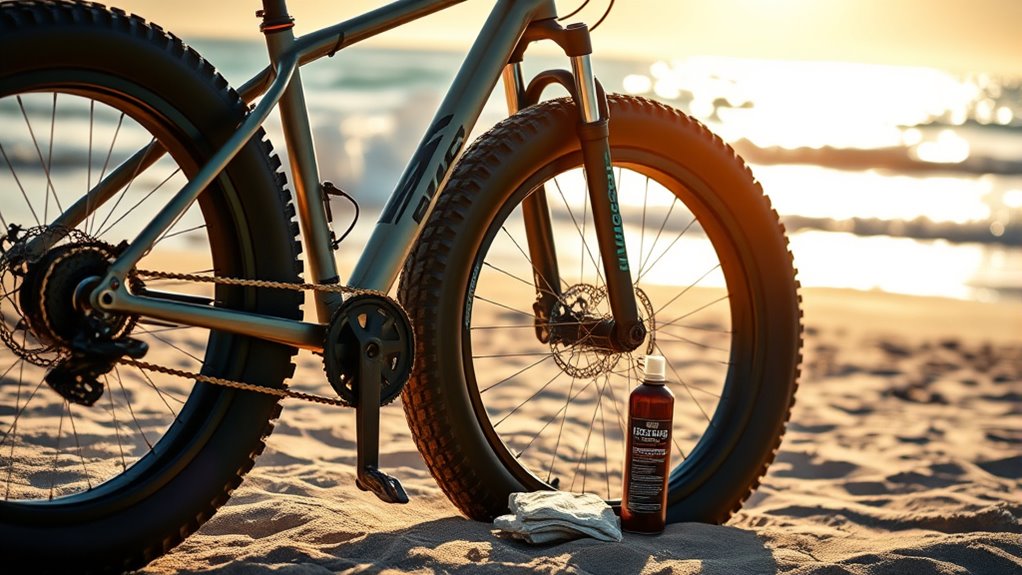
Salt and moisture from the ocean can quickly cause corrosion and damage to your bike if you’re not careful. To protect your ride, take these steps seriously.
- Rinse your bike thoroughly with fresh water after each ride to wash away salt and grime.
- Dry all components completely, especially moving parts and joints, to prevent rust formation.
- Apply a thin layer of bike-specific lubricant or protectant to metal surfaces to create a barrier against moisture.
- Store your bike in a dry, sheltered area away from salty air when not in use.
Regular maintenance helps prevent corrosion and extends your bike’s lifespan. Taking these precautions keeps your fat-tire bike in top shape for endless beach adventures.
Essential Accessories to Enhance Your Beach Cycling Experience
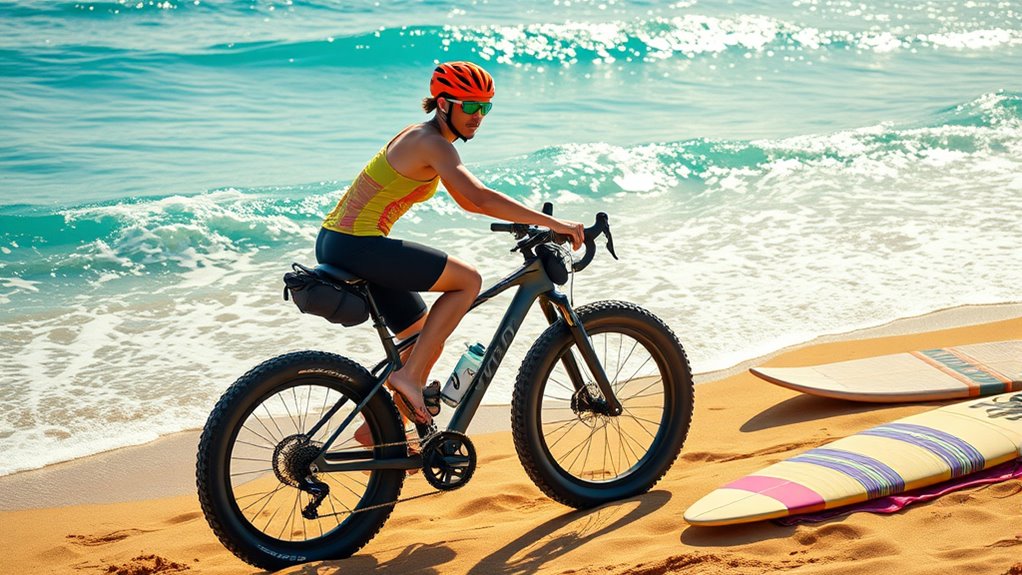
To make the most of your beach cycling adventures, having the right accessories can considerably boost your comfort, safety, and convenience. A waterproof handlebar bag keeps your essentials dry while riding on sandy, wet surfaces. Consider adding a tire pressure gauge and a portable pump to maintain ideal tire pressure for soft sand. Lights and reflectors improve visibility during early mornings or late evenings, ensuring safety. A sturdy kickstand helps you park your bike securely on uneven terrain. Sunglasses protect your eyes from glare and sand, while a hydration bottle keeps you refreshed. If you plan to carry extra gear, a rack or panniers can distribute weight evenly. These accessories make your ride smoother, safer, and more enjoyable, letting you focus on the beautiful beach scenery.
Frequently Asked Questions
How Often Should I Check My Bike’S Tire Pressure Before Beach Rides?
Before your beach rides, you should check your bike’s tire pressure at least once a week, especially if you ride frequently. Sand and salt can cause tires to lose pressure faster, so regular checks help prevent flats and guarantee a smooth ride. Always inflate your tires to the recommended PSI, usually printed on the sidewall. Doing this keeps your bike performing well and makes your beach adventures more enjoyable.
What Are Signs of Saltwater Damage on My Fat-Tire Bike?
Saltwater damage shows up as rust spots on your bike’s metal parts, especially the chain, gears, and frame. You might notice corrosion or a white, crusty residue. Salt can also cause your tires to degrade faster, leading to cracks or thinning. If you see any of these signs, it’s essential to rinse your bike thoroughly with fresh water after riding and dry it completely to prevent further damage.
Can I Ride My Fat-Tire Bike in the Ocean Surf?
Riding your fat-tire bike in the ocean surf is like dancing on a tightrope—thrilling but risky. While some riders venture into shallow waves, saltwater can corrode components and damage your bike’s internal parts. If you decide to go for it, rinse your bike thoroughly afterward, paying close attention to the drivetrain and bearings. Use protective lubricants to ward off corrosion, ensuring your bike stays in prime condition for future adventures.
How Do I Store My Bike After a Beach Trip?
After your beach trip, you should clean your bike thoroughly, removing sand, salt, and dirt with fresh water. Dry it completely to prevent rust, especially on metal parts. Store your bike in a dry, sheltered place away from direct sunlight and moisture. If possible, elevate it to avoid contact with damp surfaces. Regular maintenance, like lubricating the chain, helps keep your bike in top shape for next adventures.
Are There Specific Lubricants Recommended for Salt-Exposed Bike Parts?
You might think all bike lubricants work equally well, but salt exposure demands specialized care. Using a lubricant specifically designed for corrosion resistance, like a marine-grade or dry film lubricant, is highly recommended. These products form a protective barrier against salt, preventing rust and wear. Regularly applying such lubricants after rides guarantees your bike stays smooth and protected, especially after cycling along saltwater beaches.
Conclusion
Beach cycling blends adventure with serenity, but neglecting your fat-tire bike can turn that joy into frustration. Imagine the thrill of gliding over soft sand, only to face corrosion and damage afterward. By choosing the right bike, prepping properly, and maintaining it diligently, you protect your passion and extend its life. Embrace the balance: savor the freedom of beach rides while caring for your bike—because true adventure lasts when your gear is as resilient as your spirit.

